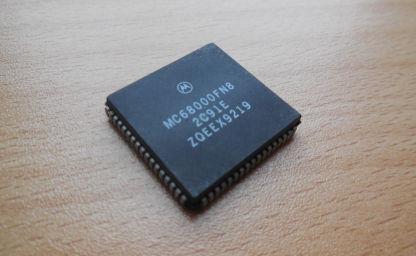Exploring the Amiga - Part 4
By Leonardo Giordani - Updated on
The Exec base functions¶
We found the Kickstart 1.3 (Exec 34.2) vector table at address 0x1a7c, and the first 4 entries read
00001a7c: 08a0
00001a7e: 08a8
00001a80: 08ac
00001a82: 08ac
If we translate these relative values into absolute addresses, summing the address of the table itself, we discover the address of the 4 base functions that every Amiga library has to provide, namely Open, Close, Expunge, and a reserved slot that should contain a function that returns 0.
Open
The first value is 0x08a0, and if we sum this value to the address of the table itself we get 0x1a7c + 0x08a0 = 0x231c. At this address we will find the first function defined in the jump table, that is Open.
The code is the following
0000231c: 200e move.l a6,d0
0000231e: 526e 0020 addq.w #0x1,0x20(a6)
00002322: 4e75 rts
The Open routine expects the address of the library to be in the a6 register, and returns the same value in d0. It then adds 1 to the number contained 32 bytes (0x20) after the address of the library itself and then returns. To find out what this number is we can go back again to the NDK and its include files.
From a previous investigation we know that, once the library has been installed in memory, there are two structures defined one after the other. The first is the LN structure that represents a linked list node, and the second is the LIB structure that represents the library.
We find the definition of LN in include_i/exec/nodes.i
STRUCTURE LN,0 ; List Node
APTR LN_SUCC ; Pointer to next (successor)
APTR LN_PRED ; Pointer to previous (predecessor)
UBYTE LN_TYPE
BYTE LN_PRI ; Priority, for sorting
APTR LN_NAME ; ID string, null terminated
LABEL LN_SIZE ; Note: word aligned
and the definition of LIB in include_i/exewc/libraries.i
STRUCTURE LIB,LN_SIZE
UBYTE LIB_FLAGS ; see below
UBYTE LIB_pad ; must be zero
UWORD LIB_NEGSIZE ; number of bytes before LIB
UWORD LIB_POSSIZE ; number of bytes after LIB
UWORD LIB_VERSION ; major
UWORD LIB_REVISION ; minor
APTR LIB_IDSTRING ; ASCII identification
ULONG LIB_SUM ; the system-calculated checksum
UWORD LIB_OPENCNT ; number of current opens
LABEL LIB_SIZE ; Warning: Size is not a longword multiple!
As you can see the latter mentions the former reserving space for it at the beginning (LN_SIZE).
LABEL is a macro that creates an alias for the current size of the structure, and you can find its definition in include_i/exec/types.i. It works in conjunction with the type macros, which increment the global variable SOFFSET. The code LABEL LN_SIZE in the LN structure produces the definition LN_SIZE EQU 14, which is thus a simple marker and does not contribute to the size of the structure itself.
The comment after the LABEL macro in the LN structure says that the structure is word aligned, and indeed its size is a multiple of a word (2 bytes): 2 APTR (8 bytes) + 1 UBYTE (1 bytes) + 1 BYTE (1 byte) + 1 APTR (4 bytes) = 14 bytes.
To find the field updated by Open we need to skip 32 bytes. So, after we skip the whole LN structure, we still have 18 bytes to skip into the LIB structure. At that offset we find the LIB_OPENCNT field (remember that UBYTE is 1 byte, UWORD 2 bytes, and APTR and ULONG 4 bytes). This field is, as the comment reads, the "number of current opens". The system counts the number of times a library has been opened because a library with zero active users can safely be removed from memory.
The last instruction of the Open function is rts (ReTurn from Subroutine) that returns to the instruction after the jsr that called the function.
Close, Expunge, and the reserved slot
Immediately after the definition of the Open function, we find the definition of Close, listed in the vector table as 0x08a8, which becomes 0x1a7c + 0x08a8 = 0x2324. The next two entries in the vector table contain the same value 0x08ac, which translates to the absolute address 0x1a7c + 0x08ac = 0x2328. This address is then the location of both the Expunge function and the reserved function that must return 0.
The code of the Close function is very simple, it just decrements the open counter (0x20 in the library). There is no explicit rts as Close uses the adjacent Expunge code for that. Since it's impossible to remove the Exec library in the Amiga system, the Expunge function of the Exec library just returns 0, which is exactly what the reserved function has to do (thus the same address in the vector table), and what Close does after having decremented the open counter.
; Close
00002324: 536e 0020 subq.w #0x1,0x20(a6)
; Expunge
00002328: 7000 moveq #0,d0
0000232a: 4e75 rts
MakeFunctions¶
The MakeFunctions routine is used by Exec to create the vector table at the beginning of the library when it is loaded in memory. You might recall that the vector table is created backward from the beginning of the library, thus allowing to use a simpler addressing scheme.
The prototype of the MakeFunctions routine is
size = MakeFunctions(addess, vectors, offset)
d0 a0 a1 a2
and the code that we found in one of the previous investigations is at offset 0x15b2
000015b2: 2f0b move.l a3,-(sp)
000015b4: 7000 moveq #0,d0
000015b6: 220a move.l a2,d1
000015b8: 6716 beq.b 0x15d0
000015ba: 3219 move.w (a1)+,d1
000015bc: 0c41 ffff cmpi.w #-0x1,d1
000015c0: 6722 beq.b 0x15e4
000015c2: 47f2 1000 lea (0,a2,d1.w),a3
000015c6: 210b move.l a3,-(a0)
000015c8: 313c 4ef9 move.w #0x4ef9,-(a0)
000015cc: 5c80 addq.l #0x6,d0
000015ce: 60ea bra.b 0x15ba
000015d0: 2219 move.l (a1)+,d1
000015d2: 0c81 ffff ffff cmpi.l #-0x1,d1
000015d8: 670a beq.b 0x15e4
000015da: 2101 move.l d1,-(a0)
000015dc: 313c 4ef9 move.w #0x4ef9,-(a0)
000015e0: 5c80 addq.l #0x6,d0
000015e2: 60ec bra.b 0x15d0
000015e4: 265f movea.l (sp)+,a3
000015e6: 4e75 rts
The code is probably easier to read if we replace the addresses with some labels
Setup:
000015b2: 2f0b move.l a3,-(sp)
000015b4: 7000 moveq #0,d0
000015b6: 220a move.l a2,d1
000015b8: 6716 beq.b Absolute
Relative:
000015ba: 3219 move.w (a1)+,d1
000015bc: 0c41 ffff cmpi.w #-0x1,d1
000015c0: 6722 beq.b Cleanup
000015c2: 47f2 1000 lea (0,a2,d1.w),a3
000015c6: 210b move.l a3,-(a0)
000015c8: 313c 4ef9 move.w #0x4ef9,-(a0)
000015cc: 5c80 addq.l #0x6,d0
000015ce: 60ea bra.b Relative
Absolute:
000015d0: 2219 move.l (a1)+,d1
000015d2: 0c81 ffff ffff cmpi.l #-0x1,d1
000015d8: 670a beq.b Cleanup
000015da: 2101 move.l d1,-(a0)
000015dc: 313c 4ef9 move.w #0x4ef9,-(a0)
000015e0: 5c80 addq.l #0x6,d0
000015e2: 60ec bra.b Absolute
Cleanup:
000015e4: 265f movea.l (sp)+,a3
000015e6: 4e75 rts
Setup
The first part of the code is
Setup:
000015b2: 2f0b move.l a3,-(sp)
000015b4: 7000 moveq #0,d0
000015b6: 220a move.l a2,d1
000015b8: 6716 beq.b Absolute
The first thing this code does is to save the a3 register in the stack because it will be changed during the routine.
Setup:
000015b2: 2f0b move.l a3,-(sp)
In Assembly, variables are provided by registers and thus are not namespaced, as the registers are the same through the whole program. This is why you should save and restore them and document which one you will change, for instance to return values.
Secondly, the code sets the d0 register to 0.
000015b4: 7000 moveq #0,d0
This register, according to the function prototype, will contain the final size of the jump table, and 0 is a sensible starting value.
Lastly, the code moves the a2 register to d1 to be able to manipulate it.
000015b6: 220a move.l a2,d1
000015b8: 6716 beq.b Absolute
This, however, also sets the processor flags according to the value of a2 itself, and those flags are used in the next beq.b instruction. If a2 contains the value 0 the table is absolute (code at 0x15d0, labelled Absolute here) otherwise it is relative (code at 0x15ba, labelled Relative here).
Relative
The second section manages relative jump vectors
Relative:
000015ba: 3219 move.w (a1)+,d1
000015bc: 0c41 ffff cmpi.w #-0x1,d1
000015c0: 6722 beq.b Cleanup
000015c2: 47f2 1000 lea (0,a2,d1.w),a3
000015c6: 210b move.l a3,-(a0)
000015c8: 313c 4ef9 move.w #0x4ef9,-(a0)
000015cc: 5c80 addq.l #0x6,d0
000015ce: 60ea bra.b Relative
This fetches one of the vectors from the address stored in a1 (the address of the vector table), immediately incrementing the register value to point at the next vector.
Relative:
000015ba: 3219 move.w (a1)+,d1
then compares it with 0xffff (or #-0x1) to see if we reached the end of the table. In that case the code jumps to the fourth section (0x15e4, labelled Cleanup here), otherwise the execution continues with the next instruction
000015bc: 0c41 ffff cmpi.w #-0x1,d1
000015c0: 6722 beq.b Cleanup
The routine then loads the effective address of the relative vector using a2 as the base addressing, and stores it in a3. This register now contains the final entry that will be part of the jump table.
000015c2: 47f2 1000 lea (0,a2,d1.w),a3
Since the address of the jump table is contained in a0, the resulting absolute vector is stored there, then the code stores the value 0x4ef9 which is the code for the jmp instruction (more on this later)
000015c6: 210b move.l a3,-(a0)
000015c8: 313c 4ef9 move.w #0x4ef9,-(a0)
Note that since we are storing the jump table at negative addresses starting from the library's base pointer we have to copy the argument (the address) first and then the function (the code for jmp). The last thing this part of the code does is to add 6 to the size of the jump table (1 word for the instruction, 2 words for the address) and then jumps back to the beginning of the loop.
000015cc: 5c80 addq.l #0x6,d0
000015ce: 60ea bra.b Relative
Absolute
The third section is very similar to the second one, because it performs the same actions, only with absolute addresses instead of relative ones.
000015d0: 2219 move.l (a1)+,d1
000015d2: 0c81 ffff ffff cmpi.l #-0x1,d1
000015d8: 670a beq.b Cleanup
000015da: 2101 move.l d1,-(a0)
000015dc: 313c 4ef9 move.w #0x4ef9,-(a0)
000015e0: 5c80 addq.l #0x6,d0
000015e2: 60ec bra.b Absolute
The only difference with the previous section is that there is no need to load the effective address, as the value contained in d1 is already absolute, so the latter can be stored directly.
Cleanup
The last section simply restores the stack pointer, popping the value of the a3 register where the pointer was previously saved, and returns to the caller.
000015e4: 265f movea.l (sp)+,a3
000015e6: 4e75 rts
Self-modifying code¶
The creation of the jump table performed by the MakeFunctions routine leverages a very powerful feature of any assembly language, that is being able to produce code that self-modifies. This feature comes from a property of machine languages called homoiconicity.
The basic idea of homoiconicity is that the language doesn't consider data and code two different things, thus allowing to use the code as an input for routines and to change it programmatically. Pay attention that self-modifying code is just one of the implications of homoiconicity, and not its definition.
Homoiconicity is a feature rarely provided by languages. It is very powerful, but it basically forces to keep the language at the level of its own AST (Abstract Syntax Tree), which in turn means that you cannot add a proper abstraction, or, if you prefer, a proper high level language, if we identify with this term a computer language that is similar to the human language.
Famous examples of high level languages that are homoiconic are Lisp and Prolog. Lisp is a language that manages lists and its syntax is based on... lists. This means that you can pass Lisp code to a function and transform it like you would do with standard data.
Back to the Motorola Assembly code, the line we are interested in is
000015c8: 313c 4ef9 move.w #0x4ef9,-(a0)
This decrements the address contained in a0 by 2 bytes, then stores at the resulting address the hexadecimal number 0x4ef9.
The interesting part is that the number 0x4ef9 has a specific meaning for the Motorola 68000 processor, and namely that of the jmp instruction. This is clearly shown by the tables in the Programmer's Reference Manual (Section 8, Instruction Format Summary, 8-15).
First we have to convert the number in binary, and we get
0x4ef9 -> 0100 1110 1111 1001
The first 10 bits (0100 1110 11) already identify a jmp instruction. The following 6 bits (111 001) identify the addressing mode, which in this case is Absolute Long or (xxx).L (Programmer's Reference Manual, 4-108). This instruction shall then be followed by a 4 bytes absolute address. Please note that the function is a jmp and not a jsr, which will then not alter the address stored in the stack; a later rts will thus return to the proper called of the function and not to the jump table.
With that move.w, then, the code writes in memory some Assembly code. Techniques like this have been and are used by games and viruses to obfuscate the code, as a static analysis of the binary will not reveal what will be there only at runtime!
What's next¶
The next article will discuss the reason behind the address 0x4 used for the Exec base address, and then will move on discussing linked lists and how Exec manages system resources using them.
Resources¶
- Motorola M68000 Family Programmer's Reference Manual - https://www.nxp.com/docs/en/reference-manual/M68000PRM.pdf
- AmigaOS Developer Docs
Feedback¶
Feel free to reach me on Twitter if you have questions. The GitHub issues page is the best place to submit corrections.
Part 4 of the Exploring the Amiga series
Related Posts
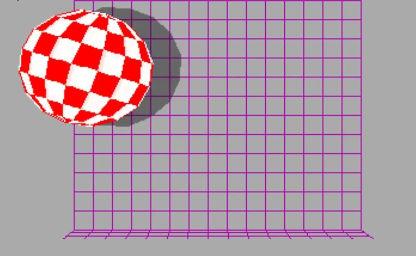
Exploring the Amiga - Part 8
Updated on
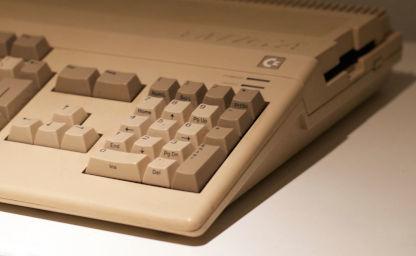
Exploring the Amiga - Part 7
Updated on

Exploring the Amiga - Part 6
Updated on

Exploring the Amiga - Part 5
Updated on
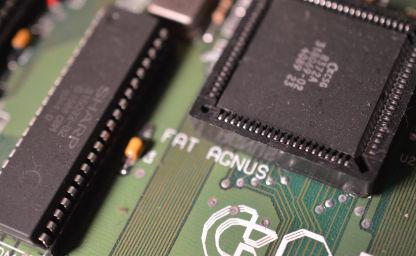
Exploring the Amiga - Part 3
Updated on

Exploring the Amiga - Part 2
Updated on
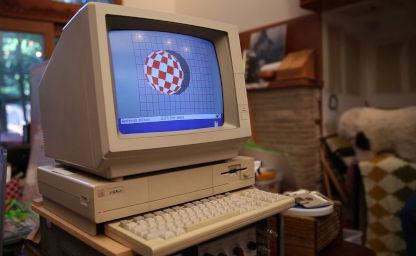
Exploring the Amiga - Part 1
Updated on
